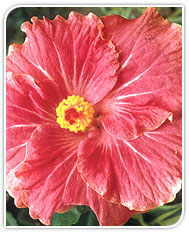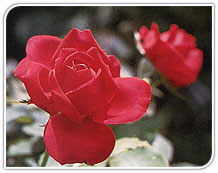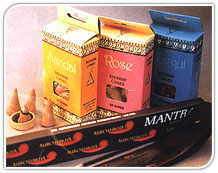Alternative Medicines: Aromatheraphy
 The
rising popularity of alternative or holistic therapy can be gauged from
the fact that today the sense of smell is also being used as a therapy to
treat an amazing variety of ailments including stress.
The
rising popularity of alternative or holistic therapy can be gauged from
the fact that today the sense of smell is also being used as a therapy to
treat an amazing variety of ailments including stress.
Flowers,
plants, herbs and spices, everyday items in our gardens or even our food,
are natural antidotes to a variety of ailments. Preventive treatments like
aromatherapy are using a combination of modern science and ancient wisdom
to produce curatives which also double as cosmetic aids. In fact, the
recuperative and soothing effects of flowers, plants and herbs have been
known for centuries. Rose petals were considered the secret of Empress
Noor Jehan's fabled beauty. Incense used in religious rituals also
possessed the properties to soothe the mind, as did Indian myrrh and dhup
make from juniper shrubs, used extensively in temples. All these performed
a dual rle-religious and therapeutic.
Now, with a growing demand
for natural cures and remedies, aromatherapy is flowering again, this time
packaged in attractive tubes and bottles and promising to cure everything
from rheumatism to diabetes and psychological problems. Aromatherapy is a
holistic healing process for the body and mind. The basis lies in the
essential oils
 contained
in plant materials. These can be found in leaves, flowers, roots, seeds,
bark and resin. These oils are highly concentrated and when extracted, can
either be used in a poure form or diluted/blended with other oils to
produce the required strength. Essential oils are medicinal and fragrant
and travel through the bloodstream reacting with hormones and enzymes.
Physiologically, the oils sedate or stimulate the system. When the
fragranceis inhaled, the nerve-ends in the nose transmit pleasurable
signals to the brain which reacts to the positive power of the fragrant
aroma inducing pleasant memories, restoring emotional valance and
encouraging relaxation and exercitation. Many of these fragrant oils have
antiseptic and antioxic qualities and often act as an antidote to viral
infections, to inflammation, aches and pains.
contained
in plant materials. These can be found in leaves, flowers, roots, seeds,
bark and resin. These oils are highly concentrated and when extracted, can
either be used in a poure form or diluted/blended with other oils to
produce the required strength. Essential oils are medicinal and fragrant
and travel through the bloodstream reacting with hormones and enzymes.
Physiologically, the oils sedate or stimulate the system. When the
fragranceis inhaled, the nerve-ends in the nose transmit pleasurable
signals to the brain which reacts to the positive power of the fragrant
aroma inducing pleasant memories, restoring emotional valance and
encouraging relaxation and exercitation. Many of these fragrant oils have
antiseptic and antioxic qualities and often act as an antidote to viral
infections, to inflammation, aches and pains.
In India, Ayurveda
embraced herbs and aromatics as an important part of the philosophy of
healing, using fresh herbs, dried herbs such as tea, or herbs compounded
into a powder and often hand rolled into pills, using fresh plants juices.
In early times essential oil extraction involved pounding and grinding of
fresh or dried herv, and subsequent extraction of the essential oil.
 The
art of steam distillation, using ceramic or pottery stills was perfected
three to four thousand years ago and is still in use today. Trade and wars
brought many new herbs to India from the Far East, the Middle East, Egypt
and Africa. Distillation expertise from Arabia allowed for the making of
attars, using a codistillation method in which a very light volatile
essential component, such as jasmine, could be distilled with a very heavy
essential oil component like sandalwood, where the heavier component
trapped the light flowery aroma. Today essential oil production continues
to be an important industry in many small villages where distillation
apparatus designs have not changed for 3,000 years.
The
art of steam distillation, using ceramic or pottery stills was perfected
three to four thousand years ago and is still in use today. Trade and wars
brought many new herbs to India from the Far East, the Middle East, Egypt
and Africa. Distillation expertise from Arabia allowed for the making of
attars, using a codistillation method in which a very light volatile
essential component, such as jasmine, could be distilled with a very heavy
essential oil component like sandalwood, where the heavier component
trapped the light flowery aroma. Today essential oil production continues
to be an important industry in many small villages where distillation
apparatus designs have not changed for 3,000 years.
Aromatherapy
has regained popularity only two decades back. Various products based on
essential oils and natural ingredients are available designed to alter or
enhance moods and treat a range of ailments from migraine of hypertension
and, arthritis.
At various beauty saloons a variety of creams,
conditioners and moisturizers made from essential oils are used in beauty
treatments.
Alternative
Medicines
 The
rising popularity of alternative or holistic therapy can be gauged from
the fact that today the sense of smell is also being used as a therapy to
treat an amazing variety of ailments including stress.
The
rising popularity of alternative or holistic therapy can be gauged from
the fact that today the sense of smell is also being used as a therapy to
treat an amazing variety of ailments including stress.  contained
in plant materials. These can be found in leaves, flowers, roots, seeds,
bark and resin. These oils are highly concentrated and when extracted, can
either be used in a poure form or diluted/blended with other oils to
produce the required strength. Essential oils are medicinal and fragrant
and travel through the bloodstream reacting with hormones and enzymes.
Physiologically, the oils sedate or stimulate the system. When the
fragranceis inhaled, the nerve-ends in the nose transmit pleasurable
signals to the brain which reacts to the positive power of the fragrant
aroma inducing pleasant memories, restoring emotional valance and
encouraging relaxation and exercitation. Many of these fragrant oils have
antiseptic and antioxic qualities and often act as an antidote to viral
infections, to inflammation, aches and pains.
contained
in plant materials. These can be found in leaves, flowers, roots, seeds,
bark and resin. These oils are highly concentrated and when extracted, can
either be used in a poure form or diluted/blended with other oils to
produce the required strength. Essential oils are medicinal and fragrant
and travel through the bloodstream reacting with hormones and enzymes.
Physiologically, the oils sedate or stimulate the system. When the
fragranceis inhaled, the nerve-ends in the nose transmit pleasurable
signals to the brain which reacts to the positive power of the fragrant
aroma inducing pleasant memories, restoring emotional valance and
encouraging relaxation and exercitation. Many of these fragrant oils have
antiseptic and antioxic qualities and often act as an antidote to viral
infections, to inflammation, aches and pains.  The
art of steam distillation, using ceramic or pottery stills was perfected
three to four thousand years ago and is still in use today. Trade and wars
brought many new herbs to India from the Far East, the Middle East, Egypt
and Africa. Distillation expertise from Arabia allowed for the making of
attars, using a codistillation method in which a very light volatile
essential component, such as jasmine, could be distilled with a very heavy
essential oil component like sandalwood, where the heavier component
trapped the light flowery aroma. Today essential oil production continues
to be an important industry in many small villages where distillation
apparatus designs have not changed for 3,000 years.
The
art of steam distillation, using ceramic or pottery stills was perfected
three to four thousand years ago and is still in use today. Trade and wars
brought many new herbs to India from the Far East, the Middle East, Egypt
and Africa. Distillation expertise from Arabia allowed for the making of
attars, using a codistillation method in which a very light volatile
essential component, such as jasmine, could be distilled with a very heavy
essential oil component like sandalwood, where the heavier component
trapped the light flowery aroma. Today essential oil production continues
to be an important industry in many small villages where distillation
apparatus designs have not changed for 3,000 years.